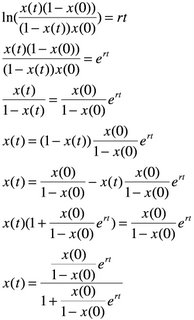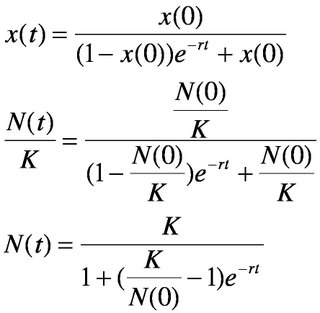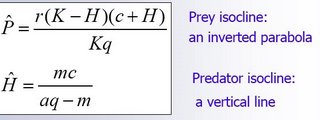Daily Science Quote #20
The making of nontrivial theory for ecology is best done by field naturalists provided that these know what science is all about.
Robert MacArthur, 1962
A blog about ecology, evolution and other aspects of biology from a theoretical perspective. In addition, this blog will also touch upon the other sciences, politics, history and random musings as they are necessary for understanding life.
The making of nontrivial theory for ecology is best done by field naturalists provided that these know what science is all about.
This is another way of saying that objects such as these cannot be explained as coming into existence by chance. As we have seen, to invoke chance, on its own, as an explanation, is equivalent to vaulting from the bottom to the top of Mount Improbable's steepest cliff in one bound. And what corresponds to inching up the kindly, grassy slopes on the other side of the mountain? It is the slow, cumulative, one-step-at-a-time, non-random survival of random variants that Darwin called natural selection. The metaphor of Mount Improbable dramatizes the mistake of the sceptics quoted at the beginning of this chapter. Where they went wrong was to keep their eyes fixed on the vertical precipice and its dramatic height. They assumed that the sheer cliff was the only way up to the summit on which are perched eyes and protein molecules and other supremely improbable arrangements of parts. It was Darwin's great achievement to discover the gentle gradients winding up the other side of the mountain.
Ecology often seems dominated by theoretical bandwagons driven by charismatic mathematicians, lost to the realization that good ecology rests on a foundation of natural history and progresses by use of proper scientific methods.
This thursday I had the pleasure of participating in a meet and greet with the leader of the NDP, Jack Layton, at Publix Bar on St-Laurent. Being a member of the NDP and all, I thought it would be a good opportunity to pick Jack's brain about the abyssmal state of science education in the country. In order to do so, I decided to invoke the case of Professor Brian Alters,a McGill professor who had a research grant turned downed by the SSHRC (Social Science and Humanities Research Council). Professor Alters was interested in investigating the adverse effects that Intelligent Design was having on the theory of evolution and therefore science education in Canada. Amazingly, the SSHRC ruled that Alters had not supplied "adequate justification for the assumption in the proposal that the theory of evolution, and not intelligent design theory, was correct"(The Gazette, April 5 2006). Of course, this rejection of his research proposal was a first-hand demonstartion of the phenomenon Professor Alters wanted to investigate.
Nature first, then theory. Or, better, Nature and theory closely intertwined while you throw all your intellectual capital at the subject. Love the organisms for themselves first, then strain for general explanations, and, with good fortune, discoveries will follow. If they don't, the love and the pleasure will have been enough.
I am myself an empyric in natural philosophy, suffering my faith to go no further than my facts. I am pleased, however, to see the efforts of hypothetical speculation, because by the collisions of different hypotheses, truth may be elicied, and science advanced in the end.
Objectivity cannot be equated with mental blankness; rather, objectivity resides in recognizing your preferences and then subjecting them to especially harsh scrutiny—and also in a willingness to revise or abandon your theories when the tests fail (as they usually do).
On the May 16th airing of The National, Rex Murphy decided to make a complete fool of himself by making his usual pseudo-intellectual attempt at serious commentary on important issues. The important issues at hand were the gun registry and the Kyoto Protocol. While his opinions on the gun registry were misguided, they were not completely dishonest. However, he committed massive intellectual dishonesty with the following statement:
Now, Kyoto is not a registry, but it has the same impulse at its centre, vagueness of intention surrounding an amorphous good cause. The science is contentious, regardless of what the propagandists of global warning will tell you. It is advocacy-driven and as much a lobby as General Motors. (Author's emphasis)
The worst thing that can happen during the 1980s is not energy depletion, economic collapse, limited nuclear war, or conquest by a totalitarian government. As terrible as these catastrophes would be for us, they can be repaired within a few generations. The one process ongoing in the 1980s that will take millions of years to correct is the loss of genetic and species diversity by the destruction of natural habitats. This is the folly that our descendents are least likely to forgive us.
Like most mathematicians, he [Alfred Lotka] takes the hopeful biologist to the edge of the pond, points out that a
good swim will help his work, and then pushes him in and leaves him to drown.
Nothing in science -- nothing in life, for that matter -- makes sense without theory. It is our nature to put all knowledge into context in order to tell a story, and to re-create the world by this means.
Nothing in science -- nothing in life, for that matter -- makes sense without theory. It is our nature to put all knowledge into context in order to tell a story, and to re-create the world by this means.
WARNING: This post contains calculus, phase planes, time series and other mathematical concepts that may be horrifically boring to the non-mathematically inclined. Reader discretion is advised.















The important thing is not to stop questioning. Curiosity has its own reason for existing. One cannot help but be in awe when he contemplates the mysteries of eternity, of life, of the marvelous structure of reality. It is enough if one tries merely to comprehend a little of this mystery every day. Never lose a holy curiosity.
Education has failed in a very serious way to convey the most important lesson science can teach: skepticism.
At the same time, science, like other productive activities, like the state, the family, sport, is a social institution completely integrated into and influenced by the structure of all our other social institutions. The problems that science deals with, the ideas that it uses in investigating those problems, even the so-called scientific results that come out of scientific investigation, are all deeply influenced by predispositions that derive from the society in which we live. Scientists do not begin life as scientists after all, but as social beings immersed in a family, a state, a productive structure, and they view nature through a lens that has been molded by their social experience.
There is no idea, however ancient and absurd, that is not capable of improving our knowledge. The whole history of thought is absorbed into science and is used for improving every single theory. Nor is political interference rejected. It may be needed to overcome the chauvinism of science that resists alternatives to the status quo.
Nothing in Biology Makes Sense Except in the Light of Evolution.
Thus, from the war of nature, from famine and death, the most exalted object which we are capable of conceiving, namely, the production of the higher animals, directly follows. There is grandeur in this view of life, with its several powers, having been originally breathed by the Creator into a few forms or into one; and that, whilst this planet has gone cycling on according to the fixed law of gravity, from so simple a beginning endless froms most beautiful and most wonderful have been, and are being evolved.
All science is either physics or stamp collecting.
Scientific claims must be testable; we must, in principal, be able to envision a set of observations that would render them false. Miracles cannot be judged by this criterion, as Whitcomb and Morris have admitted. But is all creationists writing merely about untestable singularities? Are arguments never made in proper scientific form? Creationists do offer some testable statements, and these are amenable to scientific analysis. Why, then, do I continue to claim that creationism isn't science? Simply because these relatively few statements have been tested and conclusively refuted.